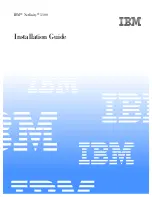
Issue 2.0
SV9100 Networking Manual
8-73
15.9 IP Phone Relocation
The IP Phone Relocation feature gives users access to their IP telephone from
any location by using the override login function. Users have the flexibility of
logging into their IP Station in the office as well as remotely at the home office.
IP Phone Relocation Override
IP Phone Relocation is a feature for overriding the registration of an IP phone
from various locations. To override the registration of an IP phone, you must have
the login ID and Password of that IP phone.
Conditions
Multiple IP Phones cannot use the same user ID and the same password at the
same time.
When a user is using multiple IP Phones at the same time, the user ID and
password must be different for each phone.
When a user is using SoftPhone (CTI mode) and controlling the IP Phone by
this SoftPhone, the user ID and password should be different for the SoftPhone
and IP Phone.
An IP Phone (IP Phone and Soft phone) with DSS console cannot override
another IP Phone.
An IP Phone (IP Phone and Soft phone) with DSS console cannot be
overridden from another IP Phone.
2-button Phones cannot use the IP Phone Relocation feature.
The login ID and Password are programmed in Program 15-05-27 and
Program 84-22.
IP Phone Relocation can be used only in Manual Registration Mode.
The system sees terminal types 1 (Economy), 2 (Value), 3 (Desi-Less), 4
(Sophisticated), and 5 (Softphone) as the same terminal type.
When using Multiple Login, the same Personal ID index can be assigned to an
ITL/Softphone and a CTI (Desktop).
Two ports of the same terminal type (Program 15-05-26) cannot be assigned to
the same Personal ID index (Program 15-05-27).
Program 10-46-01 must be set to 1 (Auto), or 2 (Manual) for Multiple Login to
work.
When three ports are assigned the same Personal ID index, in Program 15-05-
27, if Program 15-05-26 is not set for those ports, the terminal types will be
assigned based on order of login. If Program 15-05-26 is set, the login order
does not matter and they will assign the correct port.
Summary of Contents for Univerge SV9100
Page 1: ...Networking Manual A50 035910 004 AU Issue 2 0...
Page 20: ...xviii Table of Contents Issue 2 0...
Page 26: ...xxiv List of Figures Issue 2 0...
Page 33: ...Book 1 SV9100 K CCIS...
Page 49: ...Issue 2 0 1 16 General Information US Only Figure 1 15 Circuit Identification Codes CIC...
Page 53: ...Issue 2 0 1 20 General Information US Only...
Page 61: ...Issue 2 0 2 8 Hardware Installation US Only...
Page 195: ...Issue 2 0 4 116 Features and Specifications...
Page 242: ...Book 2 SV9100 IP Networking...
Page 256: ...Issue 2 0 2 12 IP Networking...
Page 312: ...Issue 2 0 4 48 Programming...
Page 376: ...Issue 2 0 6 30 SIP Trunking...
Page 391: ...Issue 2 0 7 14 H 323 Trunking...
Page 467: ...Issue 2 0 8 76 IP Multiline Station SIP...
Page 551: ...Issue 2 0 10 64 SV9100 NetLink Conditions None Feature Cross Reference None...
Page 567: ...Issue 2 0 10 80 SV9100 NetLink Conditions None Feature Cross Reference None...
Page 579: ...Issue 2 0 11 6 NAPT...
Page 580: ...Issue 2 0 SV9100 Networking Manual 11 7...
Page 581: ...Issue 2 0 11 8 NAPT...
Page 582: ...Issue 2 0 SV9100 Networking Manual 11 9...
Page 583: ...Issue 2 0 11 10 NAPT...
Page 584: ...Issue 2 0 SV9100 Networking Manual 11 11...
Page 595: ...Issue 2 0 12 4 All DSP Busy Indication...
Page 671: ...Issue 2 0 13 76 AspireNet Conditions None Feature Cross Reference None...
Page 685: ...Issue 2 0 13 90 AspireNet Department Calling Flexible System Numbering Intercom...
Page 707: ...Issue 2 0 13 112 AspireNet Default Trunk Port Number Name 1 Line 001 2 Line 002 400 Line 400...
Page 713: ...Issue 2 0 13 118 AspireNet Department Calling...
Page 765: ...Issue 2 0 13 170 AspireNet...
















































